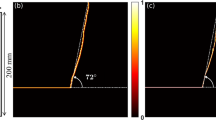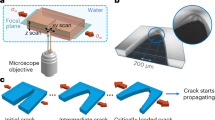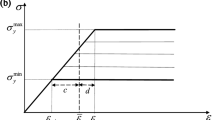Abstract
The elasticity of a solid can vary depending on its state of deformation. For example, metals will soften and polymers may stiffen as they are deformed to levels approaching failure. It is only when the deformation is infinitesimally small that elastic moduli can be considered constant, and hence the elasticity linear. Yet, many existing theories model fracture using linear elasticity, despite the fact that materials will experience extreme deformations at crack tips. Here we show by large-scale atomistic simulations that the elastic behaviour observed at large strains—hyperelasticity—can play a governing role in the dynamics of fracture, and that linear theory is incapable of fully capturing all fracture phenomena. We introduce the concept of a characteristic length scale for the energy flux near the crack tip, and demonstrate that the local hyperelastic wave speed governs the crack speed when the hyperelastic zone approaches this energy length scale.
This is a preview of subscription content, access via your institution
Access options
Subscribe to this journal
Receive 51 print issues and online access
$199.00 per year
only $3.90 per issue
Buy this article
- Purchase on Springer Link
- Instant access to full article PDF
Prices may be subject to local taxes which are calculated during checkout





Similar content being viewed by others
References
Freund, L. B. Dynamic Fracture Mechanics 2nd edn (Cambridge Univ. Press, Cambridge, UK, 1998)
Broberg, B. Cracks and Fracture (Academic, San Diego, 1999)
Slepyan, L. I. Models and Phenomena in Fracture Mechanics (Springer, Berlin, 2002)
Fineberg, J., Gross, S. P., Marder, M. & Swinney, H. L. Instability in dynamic fracture. Phys. Rev. Lett. 67, 141–144 (1991)
Ravi-Chandar, K. Dynamic fracture of nominally brittle materials. Int. J. Fract. 90, 83–102 (1998)
Abraham, F. F., Brodbeck, D., Rudge, W. E. & Xu, X. Instability of fracture—a computer-simulation investigation. Phys. Rev. Lett. 73, 272–275 (1994)
Abraham, F. F., Brodbeck, D. & Rudge, W. E. A molecular-dynamics investigation of rapid fracture mechanics. J. Mech. Phys. Solids 45, 1595–1619 (1997)
Falk, M. L., Needleman, A. & Rice, J. R. A critical evaluation of cohesive zone models of dynamic fracture. J. Phys. IV France 11, 43–50 (2001)
Washabaugh, P. D. & Knauss, W. G. A reconcilation of dynamic crack velocity and Rayleigh-wave speed in isotropic brittle solids. Int. J. Fract. 65, 97–114 (1994)
Sharon, E. & Fineberg, J. Confirming the continuum theory of dynamic brittle fracture for fast cracks. Nature 397, 333 (1999)
Field, J. E. Brittle fracture—its study and application. Contemp. Phys. 12, 1–31 (1971)
Cramer, T., Wanner, A. & Gumbsch, P. Energy dissipation and path instabilities in dynamic fracture of silicon single crystals. Phys. Rev. Lett. 85, 788–791 (2000)
Hauch, J. A. & Marder, M. P. Energy balance in dynamic fracture, investigated by a potential drop technique. Int. J. Fract. 90 (1–2), 133–151 (1998)
Hauch, J. A., Holland, D., Marder, M. P. & Swinney, H. L. Dynamic fracture in single crystal silicon. Phys. Rev. Lett. 82, 3823–3826 (1999)
Hull, D. & Beardmore, P. Velocity of propagation of cleavage cracks in Tungsten. Int. J. Fract. Mech. 2, 468–488 (1966)
Gao, H. A theory of local limiting speed in dynamic fracture. J. Mech. Phys. Solids 44, 1453–1474 (1996)
Gao, H. Elastic eaves in a hyperelastic solid near its plane-strain equibiaxial cohesive limit. Phil. Mag. Lett. 76, 307–314 (1997)
Abraham, F. F. Dynamics of brittle fracture with variable elasticity. Phys. Rev. Lett. 77, 272–275 (1996)
Abraham, F. F.. et al. Instability dynamics in three-dimensional fracture: An atomistic simulation. J. Mech. Phys. Solids 45, 1461–1471 (1997)
Rountree, C. L. et al. Atomistic aspects of crack propagation in brittle materials: Multimillion atom molecular-dynamics simulations. Annu. Rev. Mater. Res. 32, 377–400 (2002)
Zhou, S. J., Lomdahl, P. S., Thomson, R. & Holian, B. L. Dynamic crack processes via molecular-dynamics. Phys. Rev. Lett. 76, 2318–2321 (1996)
Heizler, S. I., Kessler, D. A. & Levine, H. Mode I fracture in a nonlinear lattice with viscoelastic forces. Phys. Rev. E 66, 016126 (2002)
Abraham, F. F et al. Simulating materials failure by using up to one billion atoms and the world's fastest computer: Brittle fracture. Proc. Natl Acad. Sci. USA 99, 5777–5782 (2002)
Swadener, J. G., Baskes, M. I. & Nastasi, M. Molecular dynamics simulation of brittle fracture in silicon. Phys. Rev. Lett. 89, 085503 (2002)
Abraham, F. F. The atomic dynamics of fracture. J. Mech. Phys. Solids 49, 2095–2111 (2001)
Fratini, S., Pla, O., Gonzalez, P., Guinea, F. & Louis, E. Energy radiation of moving cracks. Phys. Rev. B 66, 104104 (2002)
Abraham, F. F. & Gao, H. How fast can cracks propagate? Phys. Rev. Lett. 84, 3113–3116 (2000)
Rosakis, A. J. Intersonic shear cracks and fault ruptures. Adv. Phys. 51, 1189–1257 (2002)
Broberg, K. B. Dynamic crack propagation in a layer. Int. J. Sol. Struct. 32 (6–7), 883–896 (1995)
Allen, M. & Tildesley, D. Computer Simulation of Liquids (Oxford Univ. Press, 1989)
Knauss, W. G. Stresses in an infinite strip containing a semi-infinite crack. J. Appl. Mech. 33, 356–362 (1966)
Zimmermann, J. Continuum and Atomistic Modeling of Dislocation Nucleation at Crystal Surface Ledges PhD thesis, Stanford Univ. (1999)
Acknowledgements
F.F.A. acknowledges the generous support provided by the Humboldt Research Award for Senior US Scientists.
Author information
Authors and Affiliations
Corresponding author
Ethics declarations
Competing interests
The authors declare that they have no competing financial interests.
Rights and permissions
About this article
Cite this article
Buehler, M., Abraham, F. & Gao, H. Hyperelasticity governs dynamic fracture at a critical length scale. Nature 426, 141–146 (2003). https://doi.org/10.1038/nature02096
Received:
Accepted:
Issue Date:
DOI: https://doi.org/10.1038/nature02096
This article is cited by
-
K-nanomechanics: advancements and applications of atomistic simulations in the Korean solid mechanics community
JMST Advances (2023)
-
Intrinsic toughening and stable crack propagation in hexagonal boron nitride
Nature (2021)
-
Mathematical models of supersonic and intersonic crack propagation in linear elastodynamics
International Journal of Fracture (2021)
-
The role played by viscoelasticity in the bulk material during the propagation of a dynamic crack in elastomers
International Journal of Fracture (2021)
-
Experimental and numerical investigations on the failure processes and mechanisms of composite coal–rock specimens
Scientific Reports (2020)
Comments
By submitting a comment you agree to abide by our Terms and Community Guidelines. If you find something abusive or that does not comply with our terms or guidelines please flag it as inappropriate.



